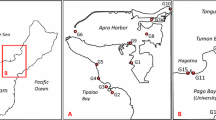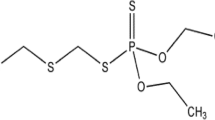Abstract
The toxicity of heavy metals to marine invertebrates has been widely investigated; however, the effects on marine sedentary polychaetes have largely been ignored. The toxicity of copper, aluminium, lead, nickel, and zinc on fertilization, embryogenesis, and larvae of Hydroides elegans was examined in laboratory acute-toxicity tests. Exposure to metal during fertilization or early developmental stages leads to fertilization block and arrested development, which resulted in morphologic abnormalities in embryo and larvae. Fertilization rate showed a drastic decrease at the highest metal concentration tested. Embryos of H. elegans showed a differential response to metals, and the responses were stage-specific. The different morphologic effects of heavy metals reflect differentiation of the early embryonic cells. For individual metals, the toxicity ranking for 24−hour trochophore larvae was Cu > Al > Pb > Ni > Zn, with EC50 values of 0.122, 0.210, 0.231, 0.316, and 0.391 mg l−1, respectively. Rate of larval development and embryogenesis were the most sensitive end points, although the latter is more advisable for routine assessment of seawater quality because of its greater simplicity. In addition to bivalves and sea urchins, polychaete embryos can provide biologic criteria for seawater quality taking into account the sensitivity of a polychaete and contributing to the detection of harmful chemicals with no marked effect on the species currently in use in seawater quality bioassays.


Similar content being viewed by others
References
Andrews JC, Anderson DT (1962) The development of the polychaete Galeolaria caespitosa Lamarck (Fam. Serpulidae). Proc Linn Soc N S W 87:185–188
American Society for Testing, Materials (1995) Standard guide for conducting acute, chronic and life cycle aquatic toxicity tests with polychaetous annelids. ASTM, Philadelphia, PA, pp 1009–1028
Baul BTS, Rynjah W, Singh KS, Pellerito C, Agati PD, Pellerito L (2005) Embryotoxicity studies of tri-n-butyltin(IV) complexes of 5-[(E)-2-(aryl)-1-diazenyl]-2-hydroxybenzoic acid and 2-[(E)-2-(3-formyl-4-hydroxyphenyl)-1-diazenyl] benzoic acid on sea urchin development. Appl Organometal Chem 19:1189–1195
Barron ESG, Nelson L, Ardo MJ (1948). Regulatory mechanism of cellular respiration. II. The role of soluble sulfhydryl groups as shown by the effect of sulfhydryl reagents on the respiration of sea urchin sp. J Gen Physiol 32:179–190
Cairns J (1995) Chemical versus biological pollution monitoring. In: Rana BC (ed) Pollution and biomonitoring. Tata-McGraw-Hill, Delhi, India, p 452
Connor PM (1972) Acute toxicity of heavy metals to some marine larvae. Mar Pollut Bull 3:190–192
Chapman PM, Dexter RN, Long ER (1987) Synoptic measures of sediments contamination, toxicity and infaunal community composition (the Sediment Quality Triad) in San Francisco Bay. Mar Ecol Prog Ser 37:75–93
Dinnel PA, Link JM, Stober QJ (1987) Improved methodology for a sea urchin sperm cell bioassay for marine waters. Arch Environ Contam Toxicol 16:23–32
Emmens CW (1948) Principles of biological assay. Chapman and Hall, London, UK
Fernandez N (1999) Toxicidad del mercurio, cobre, cadmio y plomo sobre la embriogenesis del erizo de mar (Paracentrotus lividus). Masters thesis, Universidade de Vigo
Gopalakrishnan S (2002) Effects of copper and aluminium on reproductive behaviour, gametes, fertilization and early development of a sedentary polychaete Hydroides elegans (Haswell 1883). Doctoral thesis, University of Madras, pp 170
Gopalakrishnan S, Raja PV (2002) The effects of copper on sperm and eggs of Hydroides elegans. Proceedings XX of the National Symposium on Reproductive Biology and Comparative Endocrinology. Bharathidasan University, Tiruchirappalli, pp 83–84
Hickey CW (1995) Legislation and ecotoxicity testing (editorial). Aust J Ecotox 1:83–84
His E, Beiras R, Seaman MNL (1999). The assessment of marine pollution. Bioassay with bivalve embryos and larvae. In Southward AI, Tyler PA, Young CM (eds) Advances in marine biology. Volume 37. Academic, London, UK, pp 1–178
Kobayashi N (1980) Comparative sensitivity of various developmental stages of sea urchins to some chemicals. Mar Biol 58:163–171
Krassoi R, Everett D, Anderson I (1996) Protocol for using the doughboy scallop Chlamys asperrima (Mollusca: Pectinidae) L. to test the sublethal toxicity of single compounds and effluent. National Pulp Mills Research Program Technical Report no. 17. CSIRO, Canberra, Australia, p 56
Kuppusamy (2002) Metal-ion speciation studies in coastal environmental systems of Chennai Ennore and Palar, Mahabalipuram. Doctoral thesis, University of Madras, pp 112–129
Kuppusamy MR, Giridhar VV (2006) Factor analysis of water quality characteristics including trace metal speciation in the coastal environmental system of Chennai, Ennore. Environ Int 32:174–179
Laegdsgaard P, Byrne M, Anderson DT (1991) Reproduction of sympatric populations of Heliocidaris erythrogramma and H. tuberculata (Echinoidea) in New South Wales. Mar Biol 110:359–374
Lee HH, Xu CH (1984) Effects of metals on sea urchin development: A rapid bioassay. Mar Pollut Bull 15:18–21
Marc J, Maguer C, Belle R, Mulner-Lorillon O (2002) Sharp dose- and time-dependent toxicity of mercuric chloride at the cellular level in sea urchin embryos. Arch Toxicol 76:388–391
Marsden JR, Anderson DT (1981) Larval development and metamorphosis of the Serpulid polychaete Galeolaria caespitosa Lamarck. Aust J Mar Freshwater Res 32:667–680
Nacci DE, Jackim EE, Walsh R (1986) Comparative evaluation of three rapid marine toxicity tests: Sea urchin early embryo growth test, sea urchin sperm cell toxicity test, and Microtox. Environ Toxicol Chem 5:521–525
Nipper MG, Martin ML, Williams EK (1997) The optimisation and validation of a marine toxicity test using the New Zealand echinoid, Fellaster zelandiae. Aust J Ecotox 3:109–116
Pagano G, Cipollaro M, Corsale G, Esposito A, Ragucci E, Giordano GG, et al. (1986) The sea urchin: Bioassay for the assessment of damage from environmental contaminants. In: Cairns J Jr (ed) Community toxicity testing, ASTM STP 920. American Society for Testing and Materials, Philadelphia, PA, pp 66–92
Raja PV (1999) Hydroides elegans (Haswell) an ideal organism to study pollution in seawater. XXVI International Ethological Conference, August 29, 1999, Bangalore. Adv Ethol 34:225
Rand GM, Wells PG, McCarty LS (1995) Introduction to aquatic toxicology. In: Rand GM (ed) Fundamentals of aquatic toxicology: Effects, environmental fate and risk assessment. Taylor & Francis, Washington, DC, pp 3–70
Richardson BJ, Martin M (1994) Marine and estuarine toxicity testing: A way to go? Additional sitings from northern and southern hemisphere perspectives. Mar Pollut Bull 28:138–142
Roesijadi G (1981) The significance of a low molecular weight metallothionein like proteins in marine invertebrates. Mar Environ Res 4:167–179
Ross KE, Bidwell JR (2001) A 48-h larval development toxicity test using the marine polychaete Galeolaria caespitosa Lamarck (Fam. Serpulidae) Arch Environ Contam Toxicol 40:489–496
Schroeder PC, Hermans CO (1975) Annelida: Polychaeta. In: Giese AC, Pearse JS (eds) Reproduction of marine invertebrates. Volume 3. Annelids and echiurans. Academic, New York, NY, pp 85–92
Schuel H (1978). Secretary functions of egg cortical granules in fertilization and development. A critical review. Gamete Res 1:299–382
Sellappan M (2000) Effects of oil and pesticides on fertilization and early developmental stages of sedentary polychaete, Hydroides elegans (Haswell, 1883). Doctoral thesis, University of Madras, p 194
Strathmann M (1987) Reproduction and development of marine invertebrates of the northern Pacific coast: Data for the study of eggs, embryos, and larvae. University of Washington Press, Seattle, WA, p 670
Styan CA (1998) Polyspermy, egg size, and the fertilization kinetics of free-spawning marine invertebrates. Am Nat 152:290–298
Timourian H, Watchmaker G (1972). Nickel uptake by sea urchin embryos and their subsequent development. J Exp Zool 182:379–388
Vijayavel K, Anbuselvam C, Balasubramanian MP, Deepak Samuel V, Gopalakrishnan S (2006) Measurement of biochemical components and enzyme activities in the estuarine crab Scylla tranquebarica from naphthalene contaminated habitats. Ecotoxicology 15:469–476
Wong NC, Wong MH, Shiu KK, Qiu JW (2006). Dependency of copper toxicity to polychaete larvae on algal concentration. Aquat Toxicol 77:117–125
Xie ZC, Wong NC, Qian P-Y Qiu J-W (2005) Responses of polychaete Hydroides elegans life stages to copper stress. Mar Ecol Prog Ser 285:89–96
Zann LP (1995) Our sea, our future: State of the marine environment report for Australia. Great Barrier Marine Park Authority, Queensland, Australia, pp 54–64
Zirino A, Yamamoto S. (1972) A pH dependent model for the chemical speciation of copper, zinc, cadmium and lead in sea water. Limnol Oceanogr 17:661–671
Acknowledgments
We thank Dr. Thiagarajan Raman, Department of Zoology, University of Madras, for his help in critical review and valuable comments on the manuscript.
Author information
Authors and Affiliations
Corresponding author
Rights and permissions
About this article
Cite this article
Gopalakrishnan, S., Thilagam, H. & Raja, P.V. Toxicity of Heavy Metals on Embryogenesis and Larvae of the Marine Sedentary Polychaete Hydroides elegans . Arch Environ Contam Toxicol 52, 171–178 (2007). https://doi.org/10.1007/s00244-006-0038-y
Received:
Accepted:
Published:
Issue Date:
DOI: https://doi.org/10.1007/s00244-006-0038-y




